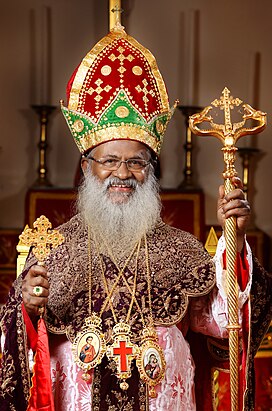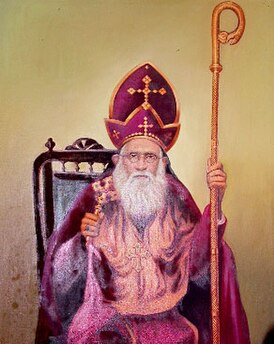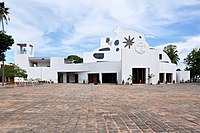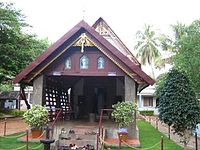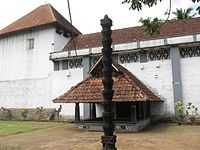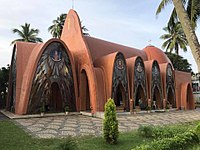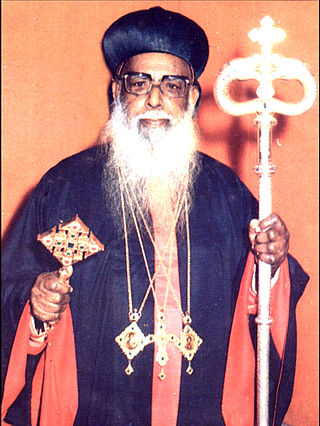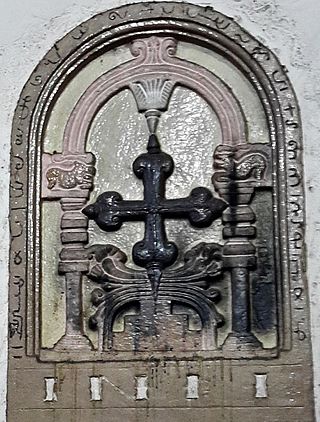This article needs additional citations for verification .(June 2019) |
| Malankara Orthodox Syrian Church (Indian Orthodox Church) | |
|---|---|
 MOSC Catholicate Palace | |
| Classification | Oriental Orthodox |
| Orientation | Eastern Christianity |
| Scripture | Peshitta |
| Theology | Miaphysitism |
| Polity | Episcopal |
| Governance | Episcopal Synod |
| Primate | Malankara Metropolitan & Catholicos of East Baselios Marthoma Mathews III |
| Region | India and the Nasrani Malayali diaspora |
| Language | Syriac, Konkani, Malayalam, English |
| Liturgy | West Syriac Rite (Malankara Rite) |
| Headquarters | Catholicate Palace, Kottayam, Kerala, India |
| Founder | Thomas the Apostle by tradition Dionysius VI [1] and Baselios Paulose I (catholicate) [2] : 285 [3] |
| Origin | 1st century by tradition, [4] 1912 |
| Independence | 1912 (Establishment of Catholicate) [5] |
| Separated from | Syriac Orthodox Church [6] : 197 |
| Branched from | Saint Thomas Christians, Malankara Church |
| Separations | Syro-Malankara Catholic Church (1930) [6] : 197 |
| Members | 0.5 million in Kerala [7] |
| Other name(s) | മലങ്കര സഭ (Malankara Church) Indian Orthodox Church |
| Official website | mosc.in |
| Part of a series on |
| Oriental Orthodoxy |
|---|
 |
| Oriental Orthodox churches |
| |
| Part of a series on |
| Christianity in India |
|---|
 |
The Malankara Orthodox Syrian Church (MOSC) [8] also known as the Indian Orthodox Church (IOC) [9] or simply as the Malankara Church, [10] is an autocephalous [11] [12] [5] Oriental Orthodox church headquartered in Devalokam, near Kottayam, India. It serves India's Saint Thomas Christian (also known as Nasrani) population. According to tradition, these communities originated in the missions of Thomas the Apostle in the 1st century (circa 52 AD). [13] It employs the Malankara Rite, an Indian form of the West Syriac liturgical rite.
The MOSC descends from the Malankara Church and its affiliation with the Syriac Orthodox Church. However, between 1909 and 1912, a schism over the authority of the Syriac Orthodox Patriarch of Antioch's authority resulted in the dissolution of the unified Malankara Church and establishment of the overlapping and conflicting MOSC and Jacobite Syrian Christian Church (JSCC). [3] Since 1912, the MOSC has maintained a catholicate, the Catholicos of the East and Malankara Metropolitan–presently Baselios Marthoma Mathews III–who is the primate of the church. The MOSC drafted and formally adopted a constitution in 1934, in order to define the relationship it has with the Syriac Orthodox Church and the patriarch, wherein it defined itself a division of the Syriac Orthodox Church with its supreme spiritual leader being the Patriarch of Antioch. However the constitution stipulated that all the spiritual duties of the patriarch in the Malankara Church was entrusted to the Catholicos of the East and reiterated that its administration was the prerogative of the Malankara Metropolitan. The constitution further declared that the positions of the Catholicos of the East and Malankara Metropolitan are to be held by the same person from then on, who shall henceforth act as the spiritual and administrative head of the church. [14] The Malankara Orthodox Syrian Church asserts communion with the other Oriental Orthodox churches. However, regular legal and occasional physical confrontations between the MOSC and the Syriac Orthodox JSCC have continued despite multiple efforts to reconcile the churches. [3] [15] [2] : 272
The Malankara Orthodox Syrian Church accepts miaphysitism, [16] [17] which holds that in the one person of Jesus Christ, divinity and humanity are united in one (μία, mia) nature (φύσις – "physis") without separation, without confusion, without alteration and without mixing [18] where Christ is consubstantial with God the Father. Around 500 bishops within the Patriarchates of Alexandria, Antioch and Jerusalem refused to accept the dyophysitism (two natures) doctrine decreed by the 4th ecumenical council, the Council of Chalcedon in 451,[ dubious ] an incident that resulted in the second major split in the main body of the Christian Church (after the Nestorian schism). While the Oriental Orthodox churches rejected the Chalcedonian definition, the sees that would later become the Catholic Church and the Eastern Orthodox Church accepted this council. [19]
Self-reporting roughly 2.5 million members (with external estimates of roughly 1 million) [20] across 30 dioceses worldwide, a significant proportion of the Malankara Orthodox Syrian Church's adherents reside in the southern India state of Kerala with the diaspora communities in North America, Europe, the Middle East, Malaysia, Singapore, Australia and New Zealand. [21]

